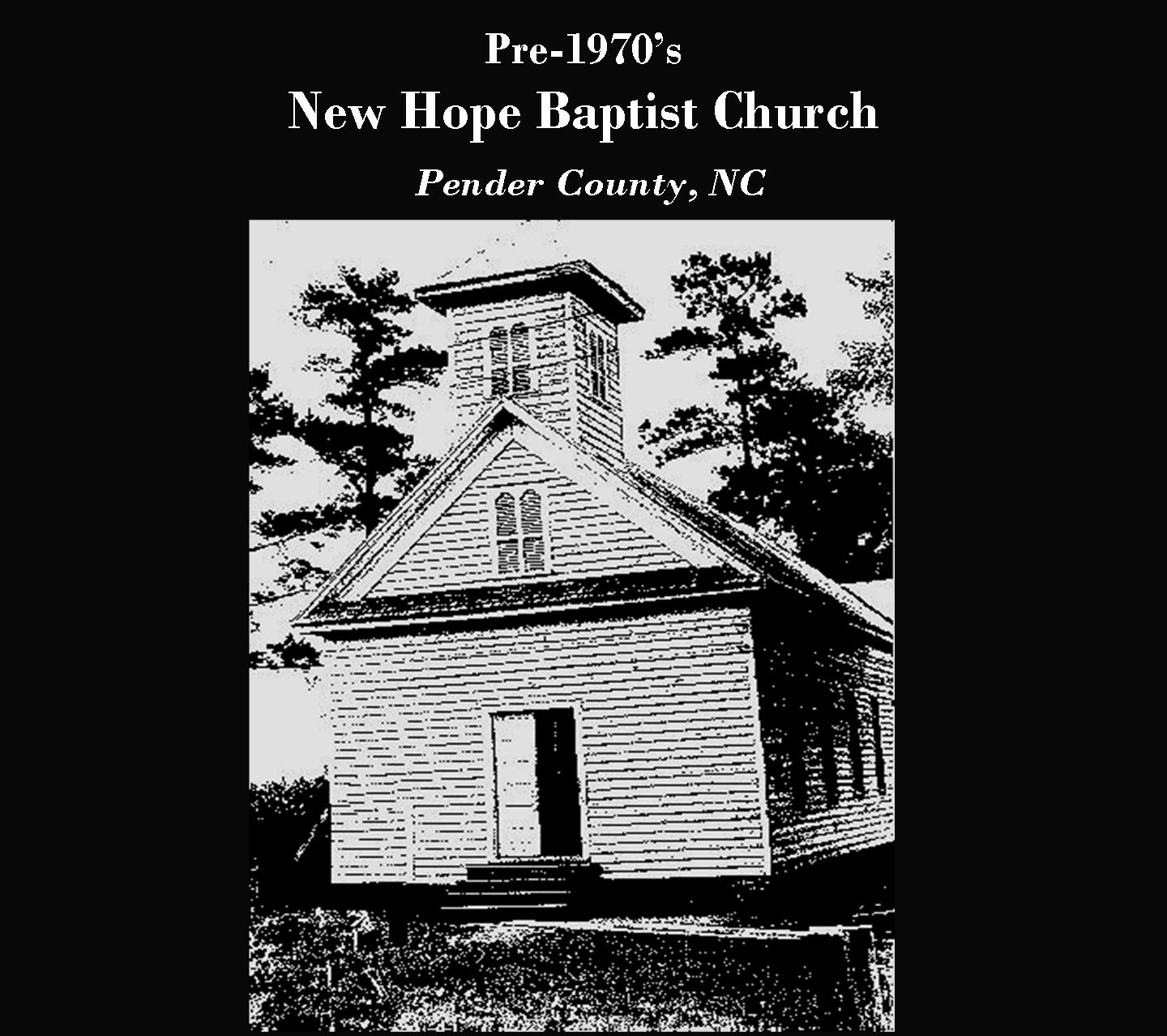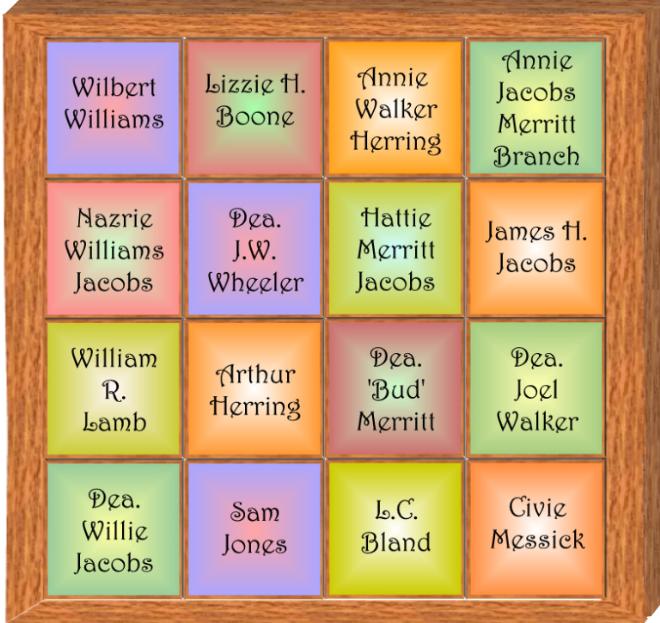 New Hope Missionary Baptist Church, Piney Wood Road, Watha, NC is the original family church of most of the PenderROCK people. It stands on Piney Wood Road, at Rhynes Crossroads, eight miles from Burgaw. New Hope is a member of the Kenansville-Eastern Missionary Baptist Association.
New Hope Missionary Baptist Church, Piney Wood Road, Watha, NC is the original family church of most of the PenderROCK people. It stands on Piney Wood Road, at Rhynes Crossroads, eight miles from Burgaw. New Hope is a member of the Kenansville-Eastern Missionary Baptist Association.
A Love Grove Church also existed at Rhynes Crossroads many years ago. Some PenderROCK elders recalled that ‘New Hope used to be called Love Grove’. Willie Henry Jacobs (b. 1907) remembered that Love Grove Church was ‘back in the woods’, but ‘they moved it out’ to the road.
Love Grove was also the name of the schoolhouse. This is the elementary/junior high school that PenderROCK people attended from at least the late 1890’s (Arthur Cleveland Herring 1886-1963 attended. Carrie Herring Walker b. Sept 1900 attended) until it was closed in 19XX. Other elders stated that Love Grove Church was side by side with New Hope Church, and near Love Grove School.
Kenansville-Eastern Missionary Baptist Association records <link) mention Love Grove Missionary Baptist Church as early as 1880 – the tenth year of the association. During the years researched [1880-1925] Love Grove – often pastor-less -- was usually the smallest and least active congregation in the association of more than twenty churches.
An in-depth analysis of Rhynes Crossroads deeds in 2020 solved "the Love Grove mystery". Love Grove Missionary Baptist Church was a small congregation on the outskirts of Wilmington; and a member of KEMBA, therefore affiliated with New Hope. Love Grove AME Church was a Rhynes Crossroads congregation. It appears on postal maps as late as mid-1930s, then disappears.
From 1880 to 1902, the Sampson County cousins who were solidifying their status as Native American were also members of the Kenansville-Eastern Missionary Baptist Association. After 1902, these Manuels, Mainors, and Jacobs are no longer listed in the minutes, as they had begun to draw firmer lines between themselves and the cousins that did not identify as Native American.
New Hope Missionary Baptist Church is not listed in the 1902 minutes of the association. The next available set of minutes is 1912. There, New Hope is in the statistical tables of members, pastors, funds, etc. – although there are no entries for New Hope. One can conclude that New Hope Baptist Church was founded between 1902-1912.
The Jacobs, Merritts, Walkers, Wheelers, Messicks, Williams were members and leaders at New Hope Missionary Baptist Church – and still are.[1] The Kenansville-Eastern Missionary Baptist Association minutes reflect that the deacons and delegates of New Hope were consistently PenderROCK people. Oddly, the pastor never was – and never has been – although there are a plethora of ministers amongst the PenderROCK people.[2]
The 1917 minutes note that William Messick was church clerk for New Hope Baptist Church. His brothers, Thomas and Luther, would be deacons later; as would Luther’s son David Messick up until 1999.
Jesse W. Wheeler was a deacon at New Hope in 1917. Most Wheelers affiliated with New Hope, but Jesse’s brother Hiram J. Wheeler is listed as a deacon at nearby Hall’s Chapel Baptist Church.
James F. Walker was the second deacon New Hope sent to the association convention in 1917. Today, most Walkers are Pentecostal and there is scant memory of them ever being any other denomination. However, progenitor J.F. Walker and his fifteen children were all strong members of New Hope Baptist until the 1930’s. Then, as a group, they broke with the church – and with the Baptist denomination – and began attending and establishing small Pentecostal congregations. The exact reason for the split is not remembered. However it probably had as much to do with the Pentecostal movement sweeping through North Carolina as it did any dissatisfaction the PenderROCK cousins had with each other.
Two of James F. Walkers brothers were members of Kenansville-Eastern Missionary Baptist Association – one quite deeply. Hanson Walker was listed as a licensed minister in 1884. Hanson lived and ministered in Wilmington and Columbus County. William H. Walker is recorded as an ordained minister in 1912. W.H. Walker held key positions in the association each year, serving as the vice-moderator of the convention in 1923.
[Not to be left out, the last Walker brother – Vance Walker – was an A.M.E. minister in Wilmington and Rose Hill, NC.]
In 1919, Joe Merritt Sr. was one of New Hope’s deacon delegates to the association. His sons, Joseph Jr. and Willie Merritt would follow soon, as would his grandson Willie Jacobs.
Although not reflected in the association minutes of this era, Willie Jacobs was a deacon by 1929 up until his death in 2002. His couasin Theat Jacobs was a long-time deacon as well. Joel Walker [J.F. Walker’s son] returned to New Hope and once again there was a Walker deacon at the home church. Joel's nephew Woodrow Walker served until his demise in 2002.
As a PenderROCK icon, New Hope Missionary Baptist Church cannot be overestimated. Southeastern Carolinians were poor, pragmatic, Spartan people. Church was the only outlet they allowed themselves other than work. The church was their sole venue to meet and greet and court and write and read and lead – and save their souls.
A key difference between the PenderROCK people and their cousins in Sampson, Robeson, and Columbus counties [who became known as the Coharie, Lumbee, and Waccamaw Indians respectively] is that the other cousins coalesced around two institutions: church and school. More widespread literacy and strong cousin/teacher/leaders enabled the people to see a way around the crippling Jim Crow laws that were applied to freed slaves and historically free people of color. Their self segregation began in their schoolhouses – refusing to attend ‘Black’ schools and unable to attend ‘White’ schools, they established their own and fought relentlessly to have the schools and pupils recognized by North Carolina as distinct and separate. [See "Divergent Paths" for an analysis of New Hope's leadership as a critical factor in PenderROCK people's current identity]
|
Pastors:
-2020 Elbert Fowler
#### A.J. Merritt (no relation)
#### Primus Henry
#### Henry Carr [source: Willie Henry Jacobs]
1923 W.H. Hall [source: K.E.M.B.A. minutes]
1913 G.P. (Pearlie) Alderman [source: Willie Henry Jacobs, K.E.M.B.A. minutes]
Deacons:
Willie Henry Jacobs -- 1929–Feb. 2002
Woodrow Walker - until 2002
Vancey Walker
David Messick -- until 1999
Theat Jacobs -- until 1981
Joel Walker -- until 1972
New Hope Deacons at annual convention in 1925:
J. W. Wheeler
T. J. Messick
Joseph Williams
Joe Merrick (sic)
New Hope Deacons at annual convention in 1924:
T. J. Messick
J. W. Wheeler
Joe Merritt
P.S. Smith (married to PenderROCK Frances Williams)
New Hope Deacons at annual convention in 1919:
J. W. Wheeler
J. F. Walker
Joseph Merritt, Sr.
New Hope Deacons at annual convention in 1913:
J. W. Wheeler
J. F. Walker
|

|
| |
Lizzie Boone is the only non-PenderROCK person with a window at New Hope Church. (And the Boones were a free family of color in Duplin/Sampson/Pender Counties also) |
Footnotes
[1] Most of the windows in the current church building commemorate or memorialize PenderROCK persons.
[2] In rural churches of this era, services led by the pastor usually occurred once a month. Sunday School every week was led by the deacons. The pastors often had two, three, or four churches – visiting one per Sunday. Thus, the deacons really managed the day-to-day activities of the church and the community. During this period, deacons would literally appear on the doorstep of a backsliding member and give them the Word to cease their sinful activities. However authoritative the role of deacon – pastors had a higher level of visibility, respect, the ability to move across communities and negotiate between groups, and the propensity to interact with regional government. The fact that the PenderROCK home church never had a PenderROCK leader/pastor is crucial. See "Divergent Paths" for an analysis of New Hope's leadership as a critical factor in PenderROCK people's current identity.